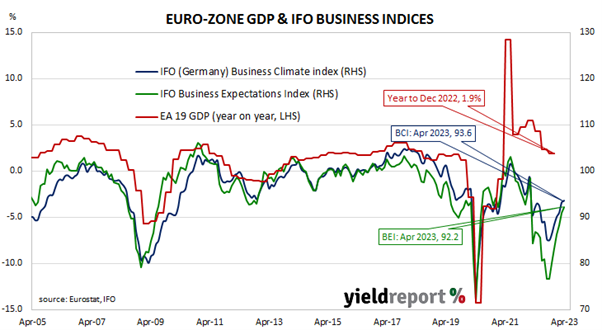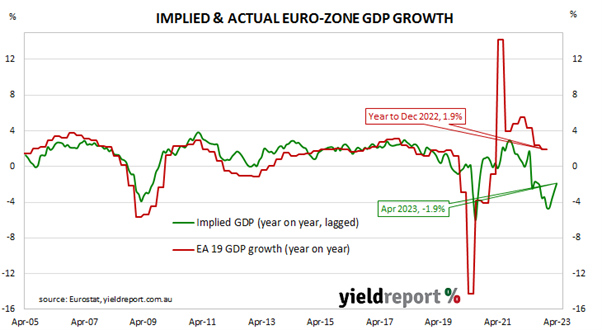Summary: ifo business climate index slightly higher in April, above expected figure; German worries “abating” but economy “lacking dynamism”; current conditions index down, expectations index up; expectations index implies euro-zone GDP contraction of 1.9% in year to July.
Following recessions in euro-zone economies in 2009/2010, the ifo Institute’s Business Climate Index largely ignored the European debt-crisis of 2010-2012, mostly posting average-to-elevated readings through to early-2020. However, the index was quick to react in the March 2020 survey, falling precipitously. Readings through much of 2021 generally fluctuated around the long-term average before dropping away in 2022.
According to the latest report released by ifo, German business sentiment has improved for a sixth consecutive month, albeit to a level which is still lower than the long-term average. April’s Business Climate Index recorded a reading of 93.6, slightly higher than the generally expected figure of 93.4 and March’s final reading of 93.2. The average reading since January 2005 is just under 97.
“German business’s worries are abating but the economy is still lacking dynamism,” said Clemens Fuest, President of the ifo Institute.
German firms’ views of current conditions deteriorated while their collective outlook improved. The current situation index slipped from March’s figure of 95.4 to 95.0 while the expectations index increased from 91.0 after revisions to 92.2.
German and French long-term bond yields both increased, noticeably so in France’s case. By the close of business, the German 10-year bund yield had added 2bps to 2.50% while the French 10-year OAT yield finished 8bps higher at 3.08%.
The ifo Institute’s business climate index is a composite index which combines German companies’ views of current conditions with their outlook for the next six months. It has similarities to consumer sentiment indices in the US such as the ones produced by The Conference Board and the University of Michigan.
It also displays a solid correlation with euro-zone GDP growth rates. However, the expectations index is a better predictor as it has a higher correlation when lagged by one quarter. April’s expectations index implies a 1.9% year-on-year GDP contraction to the end of July.



